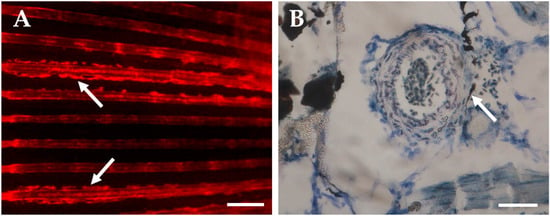The obese dragonfish is a deep-sea predator that can swallow prey up to twice its size. They are found in the pacific and indian oceans, at depths of up to 5000 feet.
The obese dragonfish, also known as the stout-swallowed dragonfish, is an extraordinary deep-sea predator that feeds on a wide variety of marine creatures. They have an elongated body, with large eyes and jagged teeth that can swallow prey up to twice their size.
These fascinating creatures inhabit the deep waters of the pacific and indian oceans, at depths of up to 5000 feet. In this article, we’ll explore the obese dragonfish and uncover the facts and secrets of this unique underwater hunter.

Credit: www.mdpi.com
Understanding The Causes Of Obesity In Dragonfish
Obesity is a serious health issue in dragonfish that can lead to a range of problems, including reduced activity, decreased vitality, and lower reproductive capacity. While a variety of factors are responsible for causing obesity in dragonfish, they can be divided into two categories: natural factors and human factors.
Natural Factors Contributing To Obesity In Dragonfish
Dietary Habits
Dietary habits are a significant cause of obesity in dragonfish. Overconsumption or underconsumption of certain types of food can have a detrimental effect on their health. Large meals at long intervals can lead to overeating, which is a common cause of obesity in dragonfish.
- Dragonfish that consume carbohydrate-rich food are more likely to be obese.
- Dragonfish that eat less protein are more likely to develop obesity.
Genetic Factors
Genetic factors also play a crucial role in obesity in dragonfish. Some dragonfish are more susceptible to obesity due to genetic factors.
- A genetic mutation in dragonfish can cause hyperphagia, leading to overeating and subsequent obesity.
- Some dragonfish species have a propensity for obesity due to their genetic makeup.
Age
Age is another crucial factor contributing to obesity in dragonfish. As dragonfish age, they tend to become less active, which can lead to weight gain. When dragonfish approach maturity, they tend to become obese, so it’s essential to monitor them closely and make necessary changes to their care.
- Adult dragonfish that are inactive are more prone to obesity.
Human Factors Contributing To Obesity In Dragonfish
Overfeeding
Overfeeding is a leading cause of obesity in dragonfish. Many owners believe that feeding their dragonfish more will help them grow faster, but this is not true. Overfeeding results in excess food being stored as fat, leading to obesity.
- A diet that is high in calories and low in protein is more likely to contribute to obesity.
- Make sure to feed your dragonfish only the recommended amount and adjust their diet as needed.
Reduced Activity
Reduced activity is another leading cause of obesity in dragonfish. If the dragonfish are in a tank with little to no activity, they are more likely to put on weight.
- It’s essential to provide your dragonfish with plenty of space to swim in.
- Add toys to their tank to encourage them to explore and stay active.
Poor Quality Food
Poor quality food is also a significant contributor to obesity in dragonfish. Feeding your dragonfish low-quality food that is high in fat and low in nutrients can lead to obesity.
- Purchase high-quality food from reputable dealers.
- Monitor your dragonfish’s diet to ensure that they are getting the right nutrition.
Obesity is a preventable condition in dragonfish by monitoring their dietary habits, following age-related care, providing adequate tank space, low-calorie, high protein diet, and exercise. Keeping in mind the natural and environmental factors of the fish that might lead to obesity is essential for their overall well-being.
Recognizing The Symptoms Of Obese Dragonfish
The dragonfish is commonly found in home aquariums. Their flashy appearance and exotic traits make them one of the sought after species. However, obesity in dragonfish is a common concern that needs immediate attention as it can lead to various health issues.
In this blog post, we will discuss the symptoms of obese dragonfish for early identification and treatment.
Physical Symptoms Of Obese Dragonfish
Identifying physical symptoms of obese dragonfish is quite simple. Here are the key points to look for:
- Round belly: Obese dragonfish have a visibly protruding belly which becomes rounder with time.
- Difficulty swimming: As their body becomes heavier, dragonfish will start finding it hard to swim. They may swim sideways or even go into a lethargic state.
- Sluggish behavior: The excessive weight causes the fish to become sluggish. They tend to spend more time at the bottom of the tank.
Behavioral Symptoms Of Obese Dragonfish
Obesity not only affects the physical features of dragonfish, but it can also lead to a few behavioral transformations. Here’s what to look for:
- Lethargy: Obese dragonfish are less active than their healthy counterparts. They will spend most of the time hiding or resting.
- Depression: As they become less active, they may become depressed and lose their interest in activities. They may also get aggressive towards other fish in the tank.
- Loss of appetite: Obese dragonfish tend to lose their appetite, which is essential for their overall health. The feeding habits change as they eat less and less.
Recognizing the symptoms of obese dragonfish is crucial to prevent any possible health complications. Prompt treatment and lifestyle changes can help the fish become healthy and active again. As a responsible pet owner, it’s your duty to keep an eye on your fish’s overall health and well-being.
Overcoming Obese Dragonfish: Tips And Tricks
Obese dragonfish are becoming a common issue among aquarium hobbyists. These overfed creatures may seem cute and chubby at first, but health problems can quickly arise. Fortunately, there are many ways to overcome obese dragonfish by developing a balanced diet, encouraging physical activity, and monitoring their health.
Developing A Balanced Diet For Dragonfish
A balanced diet is crucial for maintaining the health and wellbeing of dragonfish. Here are some tips to follow when developing a diet plan:
- Consistently offer a variety of food types, including pellets, flakes, frozen, and live foods.
- Ration the amount of food offered to prevent overfeeding. As a general rule, feed a portion that the dragonfish can finish in 2-3 minutes, once or twice a day.
- Avoid overfeeding by removing uneaten food after feeding time.
- Incorporate live foods, such as brine shrimp or bloodworms, into their diet for added nutrition.
Encouraging Physical Activity In Dragonfish
Physical activity is essential in preventing obesity and promoting a healthy lifestyle. Here are some tips to follow to encourage physical activity:
- Create an engaging aquarium environment with hiding spots, live plants, and toys.
- Provide enrichment activities, such as treats hidden inside toys, to encourage exercise and exploration.
- Avoid a sedentary lifestyle for your dragonfish by placing food in different areas of the tank to encourage movement.
Monitoring The Health Of Dragonfish
Regular monitoring of dragonfish is necessary to spot any health concerns and prevent potential issues. Here are some tips to follow when monitoring their health:
- Keep an eye out for any unusual or abnormal behavior or physical changes, such as loss of appetite, lethargy, or discoloration.
- Follow preventative measures, such as regular water changes and tank cleanings, to avoid any potential health issues.
- Consult a veterinarian if any health concerns arise or if you need further advice on maintaining your dragonfish’s health.
Developing a balanced diet, encouraging physical activity, and monitoring the health of your dragonfish is crucial in overcoming obesity in these creatures. With a little effort and care, your dragonfish will thrive, maintaining a happy and healthy life.
Frequently Asked Questions For Obese Dragonfish
What Is An Obese Dragonfish?
Obese dragonfish is a deep-sea fish with a thin and elongated body that has an oversized head and stomach. It is known for its ability to consume prey larger than their size, earning them the nickname “bulldog of the deep.
“
What Size Do Obese Dragonfish Grow?
The obese dragonfish can grow up to 23 inches long, with females generally larger than males. They have a slender body, but their stomach can expand to accommodate prey up to twice their length or equal to their weight.
What Is The Diet Of An Obese Dragonfish?
Obese dragonfish feeds on different species of prey, including squid, small fish, crustaceans, and worms. They have elongated jaws, teeth, and stomachs which enable them to swallow prey larger than their bodies. Obese dragonfish are sit-and-wait predators that use their bioluminescent photophores as lures to attract prey.
Where Can An Obese Dragonfish Be Found?
Obese dragonfish is found worldwide in deep-sea environments, usually at depths between 500 and 5000 feet. They prefer habitats with low levels of light but close to the surface to prey on animals from above.
How Do Obese Dragonfish Hunt?
Obese dragonfish are passive hunters that use their photophores to lure prey close enough before they strike. The fish then open their jaws wide to engulf the prey then retract them quickly to prevent escape. Surprisingly, the stomach can expand up to 150% of its size to accommodate such large prey.
What Are The Adaptations Of Obese Dragonfish For Deep-Sea Life?
Obese dragonfish has several adaptations to survive in the deep-sea environment, including a large head with an enormous mouth, bioluminescent photophores to attract prey, an elongated body shape to move quickly, and telescopic eyes for better vision in the darkness.
Conclusion
After learning about the obese dragonfish, it is clear that there is much to discover about the deep-sea creatures that inhabit our planet. These fascinating creatures are an inspiration to continue exploring the depths of our oceans and uncovering the mysteries that lie beneath.
As researchers continue to study and learn more about dragonfish, they will undoubtedly uncover new and exciting facts about their unique adaptations and behaviors. It is important to continue to raise awareness about these lesser-known creatures and the importance of preserving their habitats.
By doing so, we can help ensure the survival of these amazing species and the delicate balance of our oceans. The obese dragonfish serves as a reminder of the endless wonders that exist beneath the surface of our oceans and the importance of protecting and preserving our natural world.


